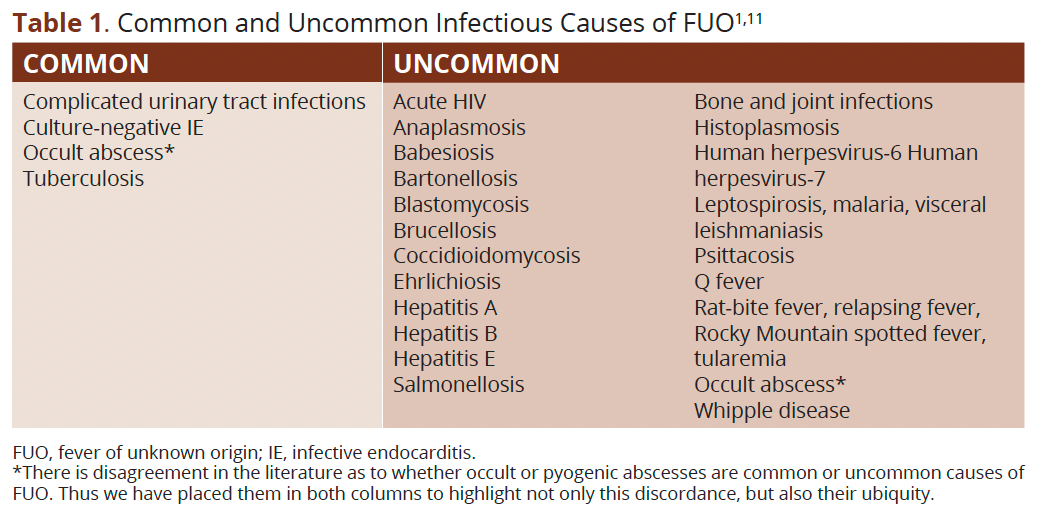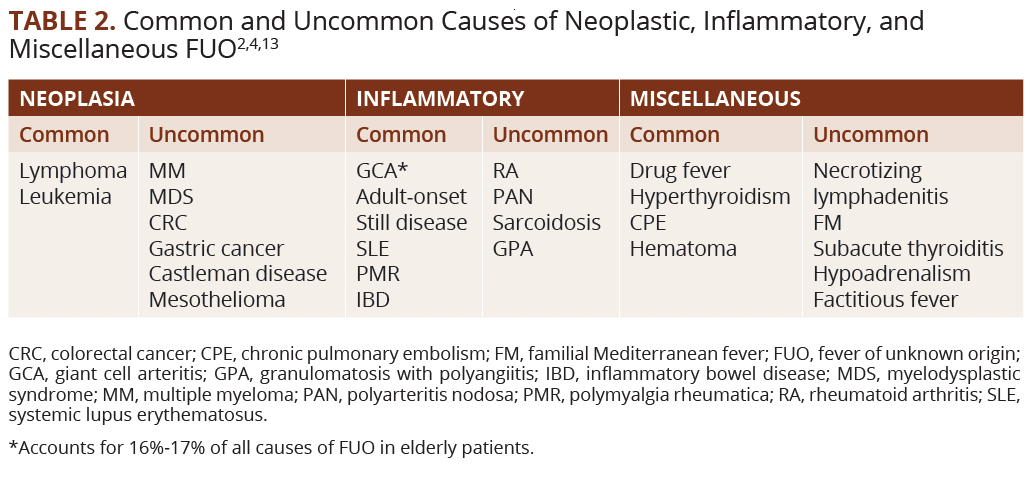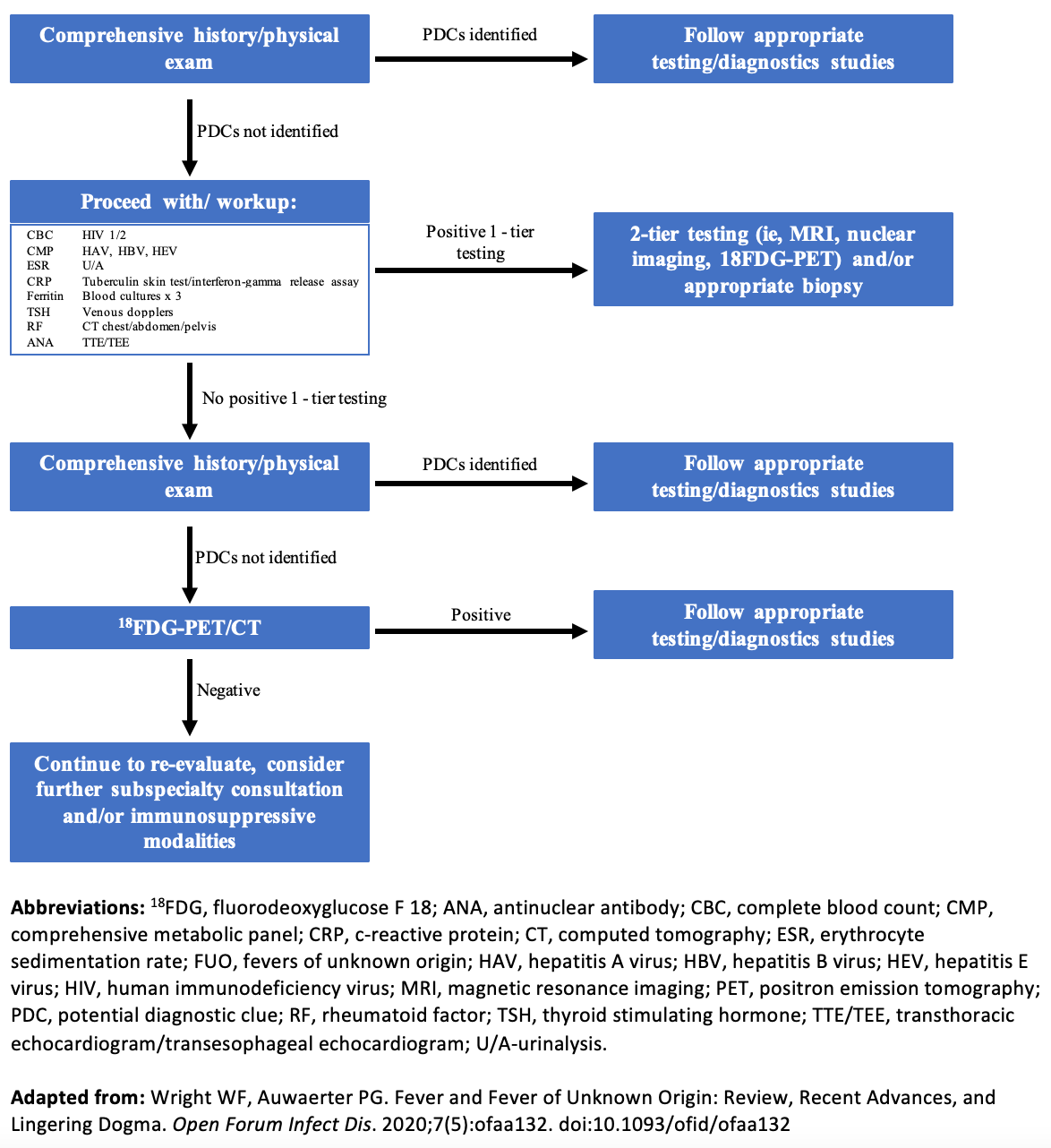Fever of Unknown Origin: What Do We Know and Where Do We Go?
As the number of etiologies increases, we must ground our application of new diagnostic modalities with appropriate assessments.

Fever of unknown origin (FUO) has, in the words of William F. Wright, DO, MPH, “fascinated and frustrated clinicians since the early days of thermometry.”1 This is why, as infectious diseases physicians, we enjoy diving into our patients’ histories and following clues to put together a story that can lead to a diagnosis. FUO epidemiology has changed over time due to the sophistication of diagnostic tools, changes in disease patterns, more immunocompromised patients in cancer treatment and transplantation settings, and the increased complexity of intensive care. Nevertheless, our approach to FUO is still largely influenced by the original definition proposed by Petersdorf and Beesom in 19611,2: fever higher than 101 ºF (38.3 ºC) on several occasions lasting at least 3 weeks with uncertain diagnosis after 1 week of study in the hospital.2 An important change in the evolution of our approach, however, has been the shift toward outpatient evaluation. As such, in 1991 Durack and Street proposed a revised definition that included 4 classes of FUO—classic, nosocomial, neutropenic, and HIV-associated—and a minimum diagnostic evaluation of 3 outpatient visits or 3 days of inpatient investigation.3,4 In 2013, Horowitz illustrated the challenges that infectious diseases consultants face with cases of FUO in highly complex patients without a clear culprit, although he still advocated for the rational use of antimicrobials.5 And with over 200 reported causes in the literature thus far, FUO poses a significant health care system burden.
What do we know about etiologies?
Classic FUO
Etiologies of this type of FUO mainly fall under one of 5 categories: infection, neoplasia, inflammatory (eg, connective tissue diseases), miscellaneous, and undiagnosed illness. In the 1950s-1960s, infections accounted for approximately 36% of cases: 18% to 19% were due to neoplasms, 15% to 17% were caused by inflammatory diseases, 13% to 19% were secondary to miscellaneous etiologies, and 9% had no diagnosis.6-8 Over time this distribution changed, with the most prominent shifts being an increase in undiagnosed cases, from 16% in the 1980s to 50% to 53% in the 2000s. In contrast, miscellaneous causes decreased from around 19% in the 1960s to 3% to 12% in the 2000s.6-8 Frequency of infections as the cause of classic FUO has been variable in the last 2 decades, with a range of 16% to 55%.4,6,9,10 Interestingly, this distribution is similar among developed vs developing countries, but the types of infections responsible for these FUOs are slightly different in each setting, with osteomyelitis being more prominent in developed countries and typhoid fever more common in developing countries.4 Infectious causes of classic FUO are listed in Table 1.1,11

FUO is generally less common in children, but infections still represent the most common etiology, including cytomegalovirus, Epstein-Barr virus, human herpesvirus (HHV)-6, HHV-7, osteomyelitis, bartonellosis, and urinary tract infections.1,12 Conversely, the frequency of infectious diseases in some cohorts of patients older than 65 years with classic FUO is lower. Additionally, connective tissue diseases predominate particularly in developed countries.8,13 Fever in the returned traveler should always be taken seriously and the cause is usually identified before the illness becomes a FUO. However, malaria, typhoid fever, and acute HIV infection are the illnesses most likely to manifest as FUO in this setting.1 Neoplastic, inflammatory, and miscellaneous causes of classic FUO are listed in Table 2.2,4,13-15

Nosocomial
Nosocomial FUO manifests as fever during hospitalization for a different illness and requires at least 3 days of investigation and 2 days of culture incubation.4 The main causes of such FUO include drug fever, postoperative complications, septic thrombophlebitis, recurrent pulmonary emboli, myocardial infarction, blood transfusion, and Clostridioides difficile colitis.1 However, countless etiologies often exist in the setting of highly complex critical care. As Harold W. Horowitz, MD, points out in his perspective article, “Fever of Unknown Origin or Fever of Too Many Origins?” the new FUO that infectious diseases consultants face is often found in critically ill patients who have multiple potential sources and relatively underwhelming or equivocal workup. These patients are usually already receiving broad spectrum antimicrobials, and decisions about expanding workup or coverage are often challenging.5
Neutropenic
Neutropenic FUO is defined as a temperature greater than 38.3° C recorded on several occasions in a patient whose neutrophil count is less than 500/μL or expected to fall to that level in 1 to 2 days. Importantly, an FUO can only be considered if 2 days or more of incubating cultures has not revealed a cause.3,4
Patients with neutropenia are at high risk of infection due to impaired immunity and it is important to keep in mind that this impaired immune response often results in atypical manifestations of disease that otherwise would be readily identified in those who are immunocompetent.1,16 The most common infectious causes of neutropenic fever include respiratory infections, secondary gram-negative bacilli bacteremia, urinary tract infections, skin and soft tissue infections, and primary bacteremia.16 Fever due to neoplasm itself and drug-induced fever are also seen but are less frequent; infection should be ruled out first and empiric treatment with antibiotics should not be delayed. In a cohort of patients with leukemia and lymphoma, neoplastic-related fever was more common in patients with cancer who were non neutropenic whereas noninfectious drug-induced fever was more frequent in those who were neutropenic.16
HIV-associated
HIV-associated FUO is defined as a temperature greater than 38.3 °C that is found on several occasions over more than 4 weeks or more than 3 days in hospitalized patients with HIV infection. This diagnosis is considered if appropriate investigations over 3 days, including 2 days of culture incubation, reveal no source.3,4 As expected, the main risk factor for FUO in people living with HIV (PLWH) is a lack of antiretroviral therapy.17,18 In general, FUO in PLWH is due to opportunistic infections, and the specific etiology largely depends on the frequency of pathogens in a particular location.1 In a case-control study conducted over 6 years in Madrid, Spain, the main causes of FUO in PLWH were mycobacterial infections, including tuberculosis (21%) and mycobacterium avium-intracellulare (25%), leishmaniasis (12%), and lymphoma (8%); 19% of cases were undiagnosed.17 Notably, noninfectious inflammatory conditions such as connective tissue diseases are very rare in this population.17-19 Similarly, a retrospective study conducted in Michigan and Boston revealed disseminated Mycobacterium avium complex as the most common etiology of HIV-associated FUO (31%), followed by Pneumocystis jirovecii pneumonia (13%), cytomegalovirus (11%), histoplasmosis (7%), lymphoma (7%), and tuberculosis (5%).20
Finding a cause
Figure

Even though the differential diagnosis of FUO is broad, a thorough history and detailed physical examination should provide key information to guide the workup in a stepwise fashion. This will help physicians to avoid obtaining unnecessary studies that may be costly and difficult to interpret in the wrong clinical context.4 A history of present illness should include travel history, animal exposure, immunosuppressive history, and therapeutic and toxin history. The continued reassessment and revisiting of the history is crucial, especially as testing results for various pathologies return. Indeed, as evidenced by research performed during a time when laboratory testing and diagnostic imaging were still rudimentary, most patients who eventually received diagnoses were not suffering from rare conditions but rather atypical presentations of more common illnesses.21
As Wright and Auwaerter emphasized in their review, many algorithms that assist with the diagnostic workup have often been indiscriminately applied, which has led to excessive testing. The authors point out that potentially diagnostic clues (PDCs) should guide further workup (Figure).4 And without a thorough assessment, such PDCs may never be elucidated.
Nuclear medicine testing and diagnostic dilemmas
This has been a controversial area in the diagnosis of FUO, especially in cases in which the initial evaluation is unrevealing. Gallium-67 and indium-111–labeled studies (via leukocyte scanning) are highly sensitive but nonspecific tests that often lead to more focused testing. Newer modalities such as 18F-fluorodeoxyglucose positron emission tomography (18FDG-PET) and magnetic resonance imaging (specifically diffusion-weighted imaging) have also shown promise in identifying anatomic sites of inflammation or infection as well as malignancy.22-24 18FDG illuminates areas of increased cellular glucose metabolism, present in many conditions; it exposes patients to less radiation than conventional computed tomography (CT) and has not been associated with nephrotoxicity.25 This modality and PET/CT have reported sensitivities that approach 85% and are useful for localizing lesions and areas that may be of further interest. For example, authors of a meta-analysis reported that 18FDG-PET combined with CT localized an undiagnosed fever source in 58% of patients.26 A growing body of evidence suggests that early implementation increases diagnostic accuracy.27 But diagnosis via an empiric “response to therapy” rarely, if ever, provides a diagnosis. Antibiotics should never be initiated for the purposes of treating fever alone and will decrease the diagnostic yield of important culture and pathology data. Although unstable patients may require time-limited empiric therapy, the concept of “emergent FUO therapy” is not one that is grounded in science. In fact, focused diagnostic testing should be prioritized in the appropriate setting.
Where do we go from here?
FUO continues to pose significant diagnostic challenges and can dramatically impact patients’ clinical courses. Advances in diagnostic and laboratory testing, although extraordinary, should not outweigh the continued reassessment of a patient’s history and physical examination to find diagnostic clues. It is to these roots of internal medicine that we should always seek to return. From this grounding, an appropriate application of technology can aid us in uncovering a diagnosis.
References
- Bennett JE,Dolin R, Blaser MJ, eds. Mandell, Douglas, and Bennett’s Principles and Practice of Infectious Diseases. 8th ed. Elsevier/Saunders; 2015. Accessed https://search.library.wisc.edu/catalog/9910208995902121
- Petersdorf RG, Beeson PB. Fever of unexplained origin: report on 100 cases: Medicine (Baltimore). 1961;40(1):1-30. doi:10.1097/00005792-196102000-00001
- Durack DT, Street AC. Fever of unknown origin––reexamined and redefined. Curr Clin Top Infect Dis. 1991;11:35-51.
- Wright WF, Auwaerter PG. Fever and fever of unknown origin: review, recent advances, and lingering dogma. Open Forum Infect Dis. 2020;7(5):ofaa132. doi:10.1093/ofid/ofaa132
- Horowitz HW. Fever of unknown origin or fever of too many origins? N Engl J Med. 2013;368(3):197-199. doi:10.1056/NEJMp1212725
- Vanderschueren S, Knockaert D, Adriaenssens T, et al. From prolonged febrile illness to fever of unknown origin: the challenge continues. Arch Intern Med. 2003;163(9):1033-1041. doi:10.1001/archinte.163.9.1033
- Bleeker-Rovers CP, Vos FJ, de Kleijn EMHA, et al. A prospective multicenter study on fever of unknown origin: the yield of a structured diagnostic protocol. Medicine (Baltimore). 2007;86(1):26-38. doi:10.1097/MD.0b013e31802fe858
- Hayakawa K, Ramasamy B, Chandrasekar PH. Fever of unknown origin: an evidence-based review. Am J Med Sci. 2012;344(4):307-316. doi:10.1097/MAJ.0b013e31824ae504
- Saltoglu N, Tasova Y, Midikli D, Aksu HSZ, Sanli A, Dündar IH. Fever of unknown origin in Turkey: evaluation of 87 cases during a nine-year-period of study. J Infect. 2004;48(1):81-85. doi:10.1016/j.jinf.2003.08.006
- Bandyopadhyay D, Bandyopadhyay R, Paul R, Roy D. Etiological study of fever of unknown origin in patients admitted to medicine ward of a teaching hospital of eastern India. J Glob Infect Dis. 2011;3(4):329-333. doi:10.4103/0974-777X.91052
- Colpan A, Onguru P, Erbay A, et al. Fever of unknown origin: analysis of 71 consecutive cases. Am J Med Sci. 2007;334(2):92-96. doi:10.1097/MAJ.0b013e31812f5642
- Zhou W, Tan X, Li Y, Tan W. Human herpes viruses are associated with classic fever of unknown origin (FUO) in Beijing patients. PLoS One. 2014;9(7):e101619. doi:10.1371/journal.pone.0101619
- Knockaert DC, Vanneste LJ, Bobbaers HJ. Fever of unknown origin in elderly patients. J Am Geriatr Soc. 1993;41(11):1187-1192. doi:10.1111/j.1532-5415.1993.tb07301.x
- Kazanjian PH. Fever of unknown origin: review of 86 patients treated in community hospitals. Clin Infect Dis. 1992;15(6):968-973. doi:10.1093/clind/15.6.968
- Mourad O, Palda V, Detsky AS. A comprehensive evidence-based approach to fever of unknown origin. Arch Intern Med. 2003;163(5):545-551. doi:10.1001/archinte.163.5.545
- Toussaint E, Bahel-Ball E, Vekemans M, et al. Causes of fever in cancer patients (prospective study over 477 episodes). Support Care Cancer. 2006;14(7):763-769. doi:10.1007/s00520-005-0898-0
- Abellán-Martínez J, Guerra-Vales JM, Fernández-Cotarelo MJ, González-Alegre MT. Evolution of the incidence and aetiology of fever of unknown origin (FUO), and survival in HIV-infected patients after HAART (highly active antiretroviral therapy). Eur J Intern Med. 2009;20(5):474-477. doi:10.1016/j.ejim.2009.01.004
- Lozano F, Torre-Cisneros J, Santos J, et al. Impact of highly active antiretroviral therapy on fever of unknown origin in HIV-infected patients. Eur J Clin Microbiol Infect Dis. 2002;21(2):137-139. doi:10.1007/s10096-001-0676-y
- Barbado FJ, Gómez-Cerezo J, Peña JM, et al. Fever of unknown origin: classic and associated with human immunodeficiency virus infection. A comparative study. J Med. 2001;32(3-4):152-162.
- Armstrong WS, Katz JT, Kazanjian PH. Human immunodeficiency virus-associated fever of unknown origin: a study of 70 patients in the United States and review. Clin Infect Dis. 1999;28(2):341-345. doi:10.1086/515138
- Zenone T. Fever of unknown origin in adults: evaluation of 144 cases in a non-university hospital. Scand J Infect Dis. 2006;38(8):632-638. doi:10.1080/00365540600606564
- Bleeker-Rovers CP, Vos FJ, Mudde AH, et al. A prospective multi-centre study of the value of FDG-PET as part of a structured diagnostic protocol in patients with fever of unknown origin. Eur J Nucl Med Mol Imaging. 2007;34(5):694-703. doi:10.1007/s00259-006-0295-z
- Gafter-Gvili A, Raibman S, Grossman A, et al. [18F]FDG-PET/CT for the diagnosis of patients with fever of unknown origin. QJM. 2015;108(4):289-298. doi:10.1093/qjmed/hcu193
- Schönau V, Vogel K, Englbrecht M, et al. The value of 18F-FDG-PET/CT in identifying the cause of fever of unknown origin (FUO) and inflammation of unknown origin (IUO): data from a prospective study. Ann Rheum Dis. 2018;77(1):70-77. doi:10.1136/annrheumdis-2017-211687
- Bharucha T, Rutherford A, Skeoch S, et al; FDG-PET/CT in fever of unknown origin working group. Diagnostic yield of FDG-PET/CT in fever of unknown origin: a systematic, meta-analysis, and Delphi exercise. Clin Radiol. 2017;72(9):764-771. doi:10.1016/j.crad.2017.02.004
- Takeuchi M, Dahabreh IJ, Nihashi T, Iwata M, Varghese GM, Terasawa T. Nuclear imaging for classic fever of unknown origin: meta-analysis. J Nucl Med. 2016;57(12):1913-1919. doi:10.2967/jnumed.116.174391
- Wright WF, Auwaerter PG, Dibble EH, Rowe SP, Mackowiak PA. Imaging a fever–– redefining the role of 2-deoxy-2-[18F]fluoro-D-glucose–positron emission tomography/computed tomography in fever of unknown origin investigations. Clin Infect Dis.2021;72(7):1279-1286. doi:10.1093/cid/ciaa1220

